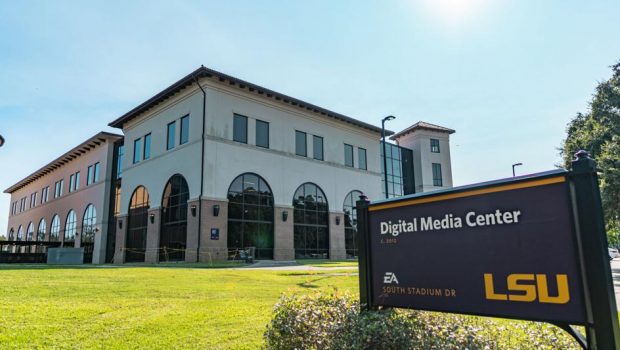The production technology that helped bring the Star Wars universe to life on Disney+ with “The Mandalorian” is coming to Baton Rouge courtesy of a $1.25 million grant LSU received from Louisiana Economic Development.
The grant comes as a part of Louisiana Economic Development’s new Entertainment Development Fund designed to improve the productivity of Louisiana’s residents in the ever-changing entertainment landscape.
Distributed in five $250,000 annual increments, the grant will be used to develop the university’s Virtual Production & Emerging Media Filmmaking program. Included is the development of a virtual production stage in the university’s Digital Media Center in the coming months.
This virtual production stage, also known as the XR studio, will feature a full LED wall and motion capture technology. Similar technology is used in Disney’s Volume technology—the virtual production tool used to create the worlds of “The Mandalorian” and the upcoming “Thor: Love and Thunder.”
“They can transport locations to the state of Louisiana and not have to shoot some of these things on location,” said Chris Stelly, Louisiana Economic Developments’ executive group director of entertainment and digital media.
Work is already underway to implement the technology required for the program, including the LED screen in the XR studio.
A portion of the screen should be in place by January, according to Jason Buch, the LSU Screen Arts program’s representative on the virtual production program.
Stelly feels that this technology allows the state to be at the forefront of education and application of this emerging technology. He said that technology has changed the face of filmmaking and this grant and the programs developed from it “will provide a lot of opportunities to train people on the most current technology with the most current programing and filmmaking techniques.”
The proposal and development of the first-of-its-kind program that is “geared towards the future of filmmaking” will allow both LSU and Louisiana to stay competitive in the film industry, Stelly said.
A key portion of LSU’s virtual production program proposal is the connection with and integration of multiple colleges across the university’s campus. The virtual production program intends to connect programs in seven of the university’s 14 colleges, ranging from the College of Engineering to the Colleges of Music & Dramatic Arts and Humanities & Social Sciences—where Screen Arts is located.
“Having access to something like this on campus is going to open up possibilities for projects students want to work on,” Buch said “And also hopefully cross-program interactions with the students where the filmmakers from the Screen Arts program can work with and enlist help from students in [Music & Dramatic Arts].”
The virtual production program and the host of different disciplines it brings together will more adequately prepare students across the university to thrive on film sets, and the world beyond entertainment.
The convergence of these technologies allow students to be prepared for more than just film, with applications ranging from the military and training for jobs on oil refineries, Stelly said.
One student part of the university’s Screen Arts program is confident the technology the grant provides will help train him for the future, but feels state-of-the-art facilities are only as good as the staff within them.
Screen Arts senior Ben Caplan feels that the current state of the program is more geared towards film studies and documentary filmmaking. Both of which are important, Caplan said, but that’s not why he came to LSU to study film.
He wants to be involved in feature length productions but doesn’t know where to start. Compared to other states like Georgia, Louisiana’s film industry is not as easy to find work in.
While Caplan is aware of a number of productions like Apple’s “Greyhound” and Disney’s “Crater” being filmed in Louisiana, he has no idea how to find work on these sets.
“Louisiana doesn’t really have a universal database of productions that’s up to date. I know Celtic [Studios in Baton Rouge] still has one of their latest productions as ‘Fantastic Four’ which came out in 2015,” Caplan said. “And if we’re gonna base Louisiana production off ‘Fantastic Four,’ I don’t think that’s a very good idea.”
He said there are changes beyond a virtual production facility that are needed to reinvigorate the Screen Arts program. He feels that hiring the right people and getting the right equipment is vital if Louisiana Economic Development's dream of making Baton Rouge a hub for cinematic productions is to come to fruition.
“Hire people that have worked in the industry today, people who are actually in the industry love to teach and develop the new wave of art,” Caplan said.
If the goal is to keep talent and attract productions to Louisiana, Caplan feels there's no better way to do that than investing in young, aspiring filmmakers.
“If LSU wants to do this they really need to find the people that are passionate about this and continue to influence that passion in the right direction,” he said.








Gloss